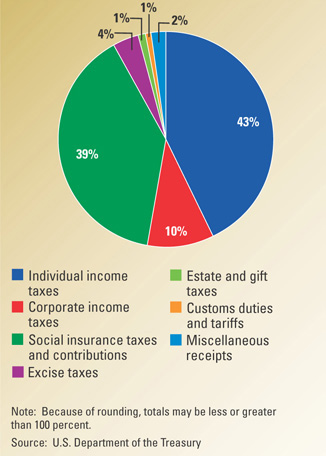Section 2 Federal Taxes
Preview
Objectives
After studying this section you will be able to:
- Describe the process of paying individual income taxes.
- Explain the basic characteristics of corporate income taxes.
- Understand the purpose of Social Security, Medicare, and unemployment taxes.
- Identify other types of taxes.
Section Focus
The federal income taxes that households and families pay help to fund government programs. Other types of taxes are levied on specific items for specific purposes.
Key Terms
- withholding
- tax return
- taxable income
- personal exemption
- deductions
- FICA
- Social Security
- Medicare
- estate tax
- gift tax
- tariff
- tax incentive
During fiscal year 2004, the federal government took in about $1.88 trillion in taxes. If you divide up this federal tax revenue among all the people in the United States, it comes to about $6,300 per person. How does the government get all this money?
The federal government has six major sources of tax revenue. They are individual and corporate income taxes, social insurance taxes, excise taxes, estate and gift taxes, and taxes on imports.
Individual Income Taxes
The federal government levies a tax on individuals' taxable income. As Figure 14.4 shows, individual income taxes make up the federal government's main source of revenue. About 45 percent of the federal government's revenues come from the payment of individual income taxes.

Image Long Description
Figure 14.4 Federal Revenue, 2004
“Pay-As-You-Earn” Taxation
The amount of federal income tax a person owes is determined on an annual basis. In theory, the federal government could wait until the end of the tax year to collect individual income taxes. In reality, that would be a problem for both taxpayers and the government. Like other employers, the government has to pay regularly for rent, supplies, services, and employees' salaries. A single annual payment from all the nation's taxpayers at once would make meeting these expenses difficult.
Similarly, many people might have trouble paying their taxes in one large sum. For these reasons, federal income tax is collected in a “pay-as-you-earn” system. This means that individuals usually pay most of their income tax throughout the year as they earn income. In mid-April, they pay any additional income taxes they owe.




